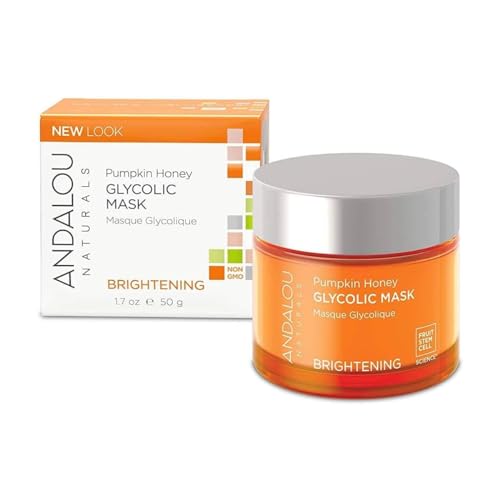
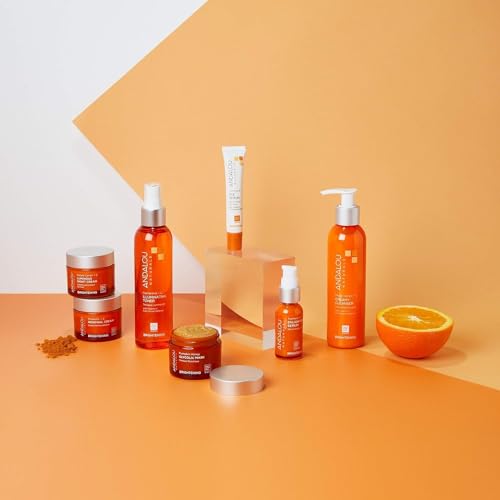
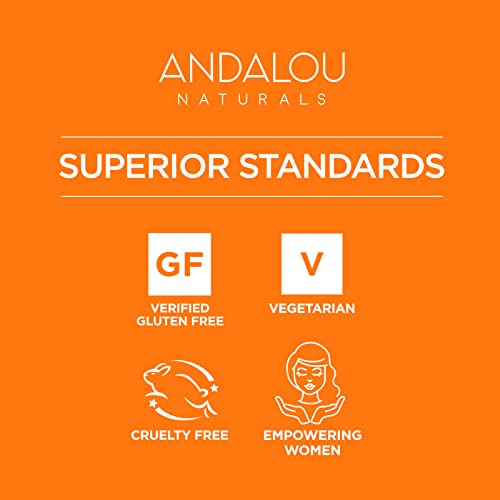
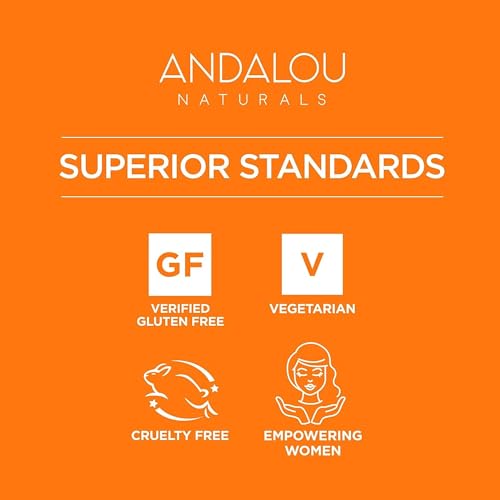
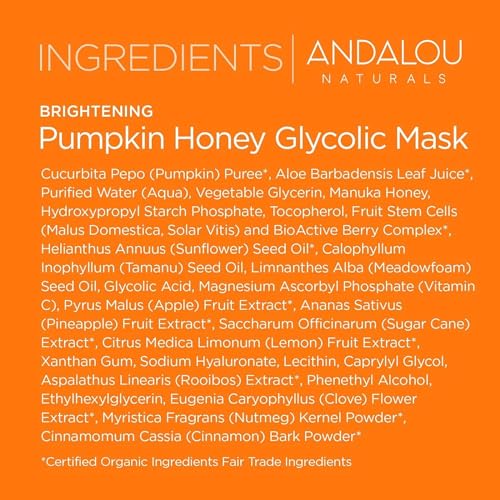
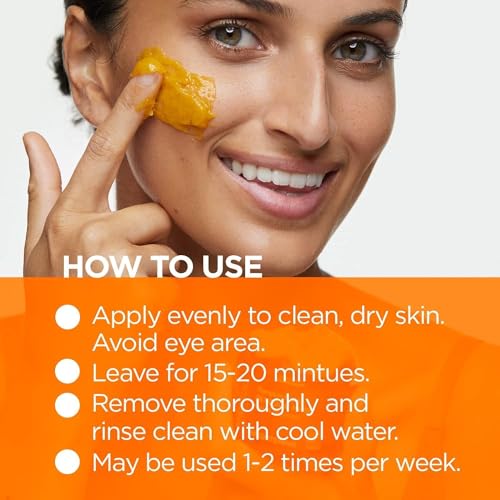
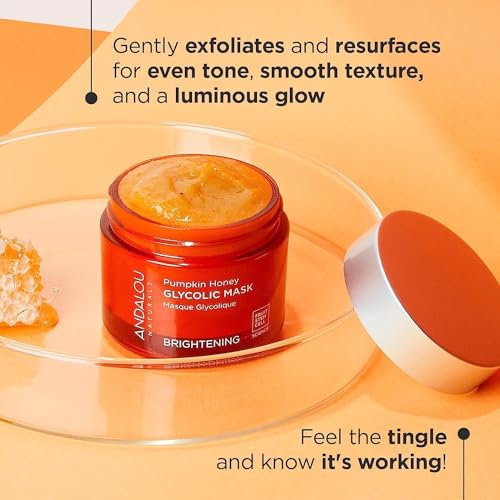
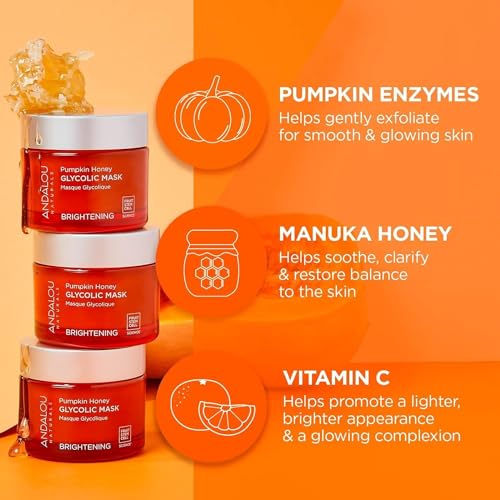
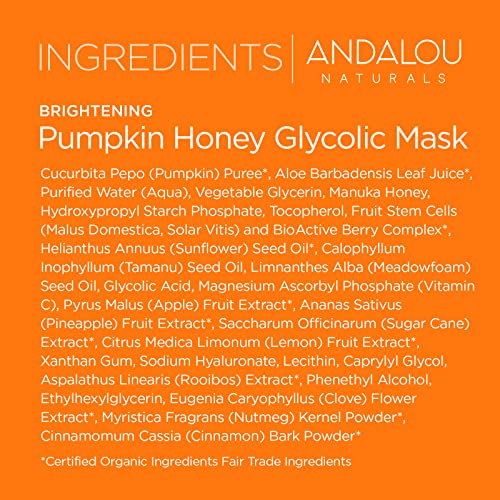
Andalou Naturals Pumpkin Honey Glycolic Mask - Exfoliating & Brightening with Vitamin C - 1.7 fl oz


Cinnamonum Cassia (Cinnamon) Bark
High RiskCinnamomum cassia (cinnamon) bark is a plant material derived from the inner bark of the Cinnamomum cassia tree, commonly used in food, cosmetics, and traditional medicine for its aromatic properties. It acts as a flavoring agent and possesses antimicrobial properties.
Sustai Insights
Cinnamomum cassia offers functional benefits as an antimicrobial agent, often utilized in cosmetic formulations. However, it has a high allergenic potential and may cause skin irritation in sensitive individuals. Regulatory bodies restrict its use in certain products due to these concerns. Overall, the ingredient is assessed as high risk due to potential health impacts, particularly for allergic reactions. Safe usage practices should be observed, and alternatives such as Cinnamomum verum (true cinnamon) might be considered for lower allergenic risk.
Eugenia Caryophyllus (Clove) Flower Extract
High RiskEugenia caryophyllus (clove) flower extract is derived from the flower buds of the clove tree, primarily used for its aromatic properties and as a natural preservative in various products. It contains bioactive compounds that may contribute to its functional benefits.
Sustai Insights
Eugenia caryophyllus (clove) flower extract offers functional benefits such as antimicrobial properties and is known for its use in aromatherapy. However, it has a high allergenic potential and may cause irritation in sensitive individuals. While it is not associated with significant carcinogenic or reproductive toxicity risks, regulatory bodies have placed some restrictions on its use. Overall, the ingredient presents a high risk level due to its potential health impacts. Safe usage practices should be observed, and alternatives like essential oils with lower allergenic potential may be considered.
Glycolic Acid
High RiskGlycolic acid is an alpha hydroxy acid (AHA) commonly used in skincare products for its exfoliating properties. It helps to improve skin texture by promoting cell turnover, thereby enhancing the appearance of the skin. It is typically derived from sugar cane and is known for its small molecular size, allowing for deeper penetration into the skin.
Sustai Insights
Glycolic acid is effective in exfoliation and can improve skin texture, making it a popular choice in cosmetic formulations. However, it presents potential health risks, such as skin irritation and enhanced absorption, which may pose challenges, especially with higher concentrations. Regulatory bodies have noted restrictions on its use due to these concerns. Environmental risks include its pollutant potential, while its high usage levels can exacerbate sensitivity in certain populations. Overall, the risks associated with glycolic acid suggest a high-risk level, necessitating cautious usage and consideration of alternatives.
Lecithin
Medium RiskLecithin is a naturally occurring lipid found in various plant and animal tissues, primarily composed of phospholipids. It serves as an emulsifier, stabilizing mixtures of oil and water, and is commonly used in food, cosmetics, and pharmaceuticals to improve texture and extend shelf life.
Sustai Insights
Lecithin provides functional benefits as an effective emulsifier and stabilizer, enhancing product texture while being sustainably sourced from natural origins. Health risks are generally low, with moderate concerns regarding allergies and immunotoxicity but minimal cancer or reproductive toxicity risks. Environmental hazards are limited, and it is not classified as a pollutant. Regulatory bodies impose few restrictions. Overall, lecithin presents a medium risk, suggesting caution in usage, especially for sensitive individuals. Alternatives include sunflower lecithin or other plant-based emulsifiers that may offer similar benefits with reduced allergenic potential.
Phenethyl Alcohol
Medium RiskPhenethyl alcohol is an aromatic alcohol commonly used in cosmetic formulations. It functions primarily as a solvent and a preservative, contributing to product stability and enhancing the fragrance profile.
Sustai Insights
Phenethyl alcohol exhibits functional benefits as a preservative and solvent in cosmetic products, with some sustainability credentials due to its natural origin. However, it is associated with moderate allergy concerns and low risks of carcinogenicity and reproductive toxicity. Regulatory bodies have imposed specific use restrictions, highlighting the need for cautious application. Overall, the risk assessment indicates a medium risk level, warranting safe usage practices and consideration of alternatives like natural preservatives.
Unspecified Extracts
Medium RiskUnspecified extracts refer to a placeholder substance page for skin care formulations, often derived from various natural sources. These extracts are utilized for their potential benefits in maintaining skin health and enhancing product efficacy, but specific functions may vary depending on the source and formulation.
Sustai Insights
Unspecified extracts can provide functional benefits such as enhancing product stability and moisturizing properties. However, they may pose health risks, including low potential for allergies and irritations. Environmental concerns may arise if sourced unsustainably. Regulatory bodies impose minimal restrictions, indicating low risk overall. Safe usage and alternatives are advisable, leading to a medium risk assessment.
Glycerin
Medium RiskGlycerin (also called glycerol) is a naturally occurring compound commonly used in personal care and cosmetic products. It functions as a humectant, attracting moisture to the skin, and is also utilized as a solvent and emollient to enhance product texture and stability.
Sustai Insights
Glycerin is valued for its effective moisturizing properties and biodegradability, making it a widely accepted ingredient in formulations. It poses low health risks, including low concerns for carcinogenicity and allergies. However, moderate use restrictions exist due to regulatory guidelines. While glycerin does not significantly contribute to environmental pollution, its production process should be ethically sourced. Overall, glycerin holds a medium risk level, emphasizing the importance of safe usage practices and considering sustainable alternatives.
Citrus Limon (Lemon) Fruit Extract
Low RiskCitrus limon (lemon) fruit extract is derived from the fruit of the lemon tree, Citrus medica limonum. It is commonly used in cosmetic and personal care formulations for its fragrance and potential skin benefits.
Sustai Insights
Citrus limon extract offers functional benefits, including natural fragrance and potential antioxidant properties. It is generally considered safe, with low concerns regarding allergies, carcinogenicity, and reproductive toxicity. However, it may cause skin irritation in sensitive individuals. Environmentally, it poses low risks, as it is biodegradable and not bioaccumulative. Regulatory agencies do not impose significant restrictions on its use. Overall, the risk level for this ingredient is low, making it a favorable choice in formulations.
Aspalathus Linearis (Rooibos) Extract
Low RiskAspalathus linearis extract is derived from the leaves of the rooibos plant, commonly used in beverages and cosmetic products for its antioxidant properties and potential skin benefits. It is known for its high content of flavonoids, which contribute to its functional role in formulations.
Sustai Insights
Aspalathus linearis extract offers functional benefits such as antioxidant properties and skin soothing effects, making it a valuable ingredient in cosmetics. It is sustainably sourced and poses low health risks, including negligible concerns for carcinogenicity and allergies. Environmental risks are minimal, with no significant pollutants or bioaccumulation issues. Regulatory assessments indicate no restrictions, reflecting its safe use in various applications. Overall, it is assessed as low risk, with no substantial adverse effects noted, making it a suitable choice for consumers.
Myristica Fragrans Powder
Low RiskMyristica fragrans powder, derived from the nutmeg seed, is used primarily as a flavoring agent and in traditional medicine. It contains essential oils and compounds that contribute to its aromatic properties, making it popular in culinary applications and natural remedies.
Sustai Insights
Myristica fragrans powder offers functional benefits as a flavor enhancer and potential antioxidant. It is generally regarded as safe, with low concerns for cancer, allergies, or reproductive toxicity. Environmental risks are minimal, and it is not classified as a pollutant. Regulatory bodies do not impose any significant restrictions on its use, yielding an overall low-risk assessment. For optimal safety, usage should remain within recommended levels, and alternatives such as other spice powders may be considered, although they may not replicate its unique properties.
Pyrus Malus (Apple) Fruit Extract
Low RiskPyrus malus (apple) fruit extract is derived from the fruit of the apple tree and is commonly used in cosmetic formulations for its nourishing properties and potential skin benefits.
Sustai Insights
Pyrus malus (apple) fruit extract offers functional benefits such as antioxidant properties and skin conditioning. It is considered low risk for health concerns, including cancer, allergies, and reproductive toxicity. Environmentally, it poses minimal risks, being non-pollutant and non-bioaccumulative. Regulatory bodies do not impose significant restrictions on its use. Overall, it is deemed low risk, making it a suitable ingredient in cosmetic products. Safe usage practices should still be observed, and alternatives may include other fruit extracts for similar benefits.
Calophyllum Inophyllum (Alexandrian Laurel) Seed Oil
Low RiskCalophyllum inophyllum seed oil is a fixed oil derived from the seeds of the Calophyllum inophyllum tree, commonly known as Alexandrian laurel. It is primarily used for its emollient properties in cosmetic formulations, offering moisturizing benefits to the skin.
Sustai Insights
Calophyllum inophyllum seed oil is valued for its emollient benefits, enhancing skin hydration and barrier function while being biodegradable and sustainably sourced. Health risks associated with this ingredient, such as irritation or allergenic potential, are considered low. Environmental concerns are minimal, with no significant pollutant or bioaccumulation risks identified. Regulatory status is compliant across various regions, with no current restrictions noted. Overall, the ingredient poses a low risk, and safe usage practices should be followed. Alternatives may include other plant-based oils with similar properties.
Fruit Stem Cell Complex
Low RiskFruit stem cell complex is derived from fruit stem cells and is commonly used in cosmetic formulations for its potential benefits in skin health. It serves primarily as a bioactive ingredient aimed at promoting skin rejuvenation and cellular repair.
Sustai Insights
Fruit stem cell complex offers functional benefits such as enhancing skin rejuvenation and cellular repair, contributing to healthier skin appearance. It is generally regarded as low risk regarding adverse health effects, with no significant concerns about carcinogenicity, allergens, or reproductive toxicity. Environmentally, it poses minimal risk, lacking bioaccumulative properties or significant pollutants. Regulatory bodies have not placed restrictions on its use. Overall, the ingredient is assessed as low risk, with safe usage practices encouraged; alternatives include other plant-derived extracts that offer similar benefits.
Cucurbita Pepo (Pumpkin)
Low RiskCucurbita pepo (pumpkin) is a gourd belonging to the Cucurbitaceae family, commonly cultivated for its edible fruit and seeds. It is often utilized in food products and cosmetics for its moisturizing properties and as a source of vitamins and antioxidants.
Sustai Insights
Cucurbita pepo exhibits functional benefits, serving as a moisturizer and a source of vitamins A and C, contributing to skin nourishment. It is sustainably sourced and biodegradable. Health risks are low, with minimal concerns regarding carcinogenicity, allergens, or toxicity. Environmental hazards are also low, with no significant pollutant potential. Regulatory bodies have not imposed restrictions on its use. Overall, the risk level associated with this ingredient is low, making it a safe choice in formulations.
Ananas Sativus (Pineapple) Fruit Extract
Low RiskAnanas sativus (pineapple) fruit extract is derived from the pineapple fruit and is commonly used in cosmetic and personal care products for its potential skin benefits, including hydration and exfoliation. It contains enzymes and vitamins that contribute to its function in formulations.
Sustai Insights
Ananas sativus extract offers functional benefits such as hydration and exfoliation due to its enzyme content. It is generally regarded as safe, with low associated health risks, including carcinogenicity, allergenic potential, and reproductive toxicity. Environmentally, it poses minimal risks, being biodegradable and sourced sustainably. Regulatory status is favorable, with no current restrictions noted. Overall, the risk level is assessed as low. For enhanced sustainability, alternatives such as plant-based enzymes may be considered.
Magnesium Ascorbyl Phosphate
Low RiskMagnesium ascorbyl phosphate is a vitamin C derivative used in cosmetics primarily for its antioxidant properties and skin-brightening effects. It is often included in formulations for its ability to stabilize vitamin C, enhancing its efficacy in skin care products.
Sustai Insights
Magnesium ascorbyl phosphate offers functional benefits as an effective antioxidant and skin-brightening agent, contributing to improved skin appearance. It has a low risk profile concerning health, with minimal concerns regarding carcinogenicity, allergies, and reproductive toxicity. Environmental risks are also low, with no significant pollutant or bioaccumulation potential noted. Regulatory assessments indicate no major restrictions, supporting its safe use in cosmetic products. Overall, the ingredient is assessed as low risk, with safe usage practices recommended for optimal effectiveness.
Hydroxypropyl Starch Phosphate
Low RiskHydroxypropyl starch phosphate is a modified starch derivative used in cosmetic formulations primarily as a thickening agent and film former. It enhances the texture and stability of products, contributing to a desirable sensory experience without altering the product's fundamental properties.
Sustai Insights
Hydroxypropyl starch phosphate offers functional benefits such as effective thickening and stabilization in cosmetic products. It has low health risks, with minimal concerns regarding carcinogenicity, allergies, or reproductive toxicity. Environmentally, it poses low risks of pollution or bioaccumulation, and it is not subject to significant regulatory restrictions. Overall, the risk level associated with this ingredient is low, making it a suitable option in formulations. Safe usage practices should be followed, and alternatives may include other modified starches or natural thickeners.
Sodium Hyaluronate
Low RiskSodium hyaluronate is the sodium salt of hyaluronic acid, a naturally occurring polysaccharide in the body. It functions primarily as a humectant in cosmetic formulations, retaining moisture and enhancing skin hydration, contributing to the overall texture and appearance of products.
Sustai Insights
Sodium hyaluronate offers several functional benefits, including effective moisture retention and skin hydration. It is considered safe with low concerns regarding carcinogenicity, allergies, or reproductive toxicity. Environmentally, it is not classified as a pollutant or bioaccumulative. Regulatory bodies do not impose significant restrictions on its use. Overall, it is assessed as low risk, making it a favorable ingredient in cosmetic formulations.
Saccharum Officinarum (Sugar Cane) Extract
Low RiskSaccharum officinarum extract, commonly known as sugar cane extract, is derived from the sugar cane plant and is primarily used for its moisturizing and humectant properties in cosmetic formulations.
Sustai Insights
Sugar cane extract provides functional benefits such as hydration and skin conditioning. It is generally recognized as safe with low health risks including negligible concerns for carcinogenicity, allergies, and reproductive toxicity. However, contamination during processing can pose risks. Environmentally, it is not bioaccumulative and does not significantly pollute. Regulatory bodies have not imposed major restrictions on its use. Overall, it presents a low risk profile, making it a viable ingredient in personal care products.
Limnanthes Versicolor (Meadowfoam) Seed Oil
Low RiskLimnanthes versicolor (meadowfoam) seed oil is derived from the seeds of the meadowfoam plant. It is commonly used in cosmetic formulations for its emollient properties, providing moisture and improving texture in skin and hair care products.
Sustai Insights
Meadowfoam seed oil offers functional benefits as a moisturizer and skin conditioner, being sustainably sourced and biodegradable. Health risks are minimal, with low concerns for carcinogenicity, allergies, and reproductive toxicity. Environmental risks are also low, with no significant pollutant potential. Current regulatory assessments do not indicate restrictions. Overall, this ingredient poses a low-risk profile, making it a suitable choice in cosmetic formulations.
Manuka Honey
Low RiskManuka honey is honey produced by bees that collect nectar from the flowers of the Manuka tree (Leptospermum scoparium), native to New Zealand and Australia. It is known for its unique properties and is commonly used in various health and beauty products for its potential benefits.
Sustai Insights
Manuka honey offers functional benefits such as antimicrobial properties and potential wound healing effects, making it valuable in skincare and medicinal applications. While it has low risks for carcinogenicity and reproductive toxicity, concerns exist regarding allergenic potential and possible endocrine disruption. Environmental risks are minimal, with no significant pollutant or bioaccumulation concerns noted. Regulatory bodies impose few restrictions, classifying it as low risk overall. Usage should be tailored to avoid allergic reactions, and alternatives like raw honey may provide similar benefits.
Water
Low RiskWater is a clear, colorless liquid essential for various biological processes. It serves as a solvent in formulations, facilitating the dissolution of other ingredients and enhancing product texture and application. Additionally, water plays a crucial role in hydration and is a key component in many cosmetic and personal care products.
Sustai Insights
Water is an effective solvent and hydrator, contributing to the texture and efficacy of formulations. It is biodegradable and generally regarded as safe, with low concerns regarding carcinogenicity, allergies, and reproductive toxicity. However, excessive water usage can lead to environmental concerns, particularly regarding resource depletion. Regulatory bodies do not impose restrictions on water use in cosmetics. Overall, the risks associated with water are low, making it a safe and essential ingredient.
Tocopherol
Low RiskTocopherols are a class of naturally occurring compounds, primarily known for their role as antioxidants. They are commonly used in cosmetic and skincare products to help stabilize formulations and protect ingredients from oxidative damage.
Sustai Insights
Tocopherols provide functional benefits such as antioxidant protection and skin conditioning. They are generally recognized as safe, with low concerns regarding carcinogenicity, allergies, and reproductive toxicity. However, enhanced skin absorption and potential endocrine disruption are noted. Regulatory bodies have not imposed significant restrictions on tocopherols, categorizing the overall risk as low. Safe usage practices should be observed, and while alternatives exist, tocopherols remain a viable option in formulations.
Xanthan Gum
Low RiskXanthan gum is a polysaccharide, a sugar-based compound produced by the fermentation of glucose or sucrose. It is commonly used as a thickening agent and stabilizer in various food and cosmetic products due to its ability to improve texture and prevent ingredient separation.
Sustai Insights
Xanthan gum serves effectively as a thickener and stabilizer, enhancing product texture and consistency. It is biodegradable and typically derived from renewable sources, supporting sustainability efforts. Health risks are minimal, with low concerns regarding carcinogenicity, allergies, and reproductive toxicity. Environmental impact is similarly low, posing no significant hazards. Regulatory agencies, including the FDA, regard it as safe for use, with no significant restrictions. Overall, xanthan gum is assessed as low risk, making it a suitable ingredient in formulations.
Caprylyl Glycol
Low RiskCaprylyl glycol (1,2-octanediol) is a multifunctional cosmetic ingredient primarily used as a skin-conditioning agent and preservative. It is derived from caprylic acid, a fatty acid found in coconut oil, and is commonly included in personal care products for its moisturizing properties.
Sustai Insights
Caprylyl glycol offers functional benefits such as acting as an effective humectant and preservative, enhancing skin hydration and product stability. It is considered to have low health risks, with no significant concerns regarding carcinogenicity, allergies, or reproductive toxicity. Environmentally, it poses minimal risks, being non-bioaccumulative and not linked to pollution. Regulatory assessments affirm its safety, with no major advisories against its use. Overall, the ingredient is assessed to have a low risk, making it a suitable choice in cosmetic formulations.
Ethylhexylglycerin
Low RiskEthylhexylglycerin is a glyceryl ether utilized primarily as a skin-conditioning agent and preservative in cosmetic formulations. It enhances the efficacy of preservatives and serves as a humectant, helping to retain moisture in the skin. This ingredient is commonly found in various personal care products.
Sustai Insights
Ethylhexylglycerin offers functional benefits as an effective preservative and skin-conditioning agent, contributing to product longevity and moisture retention. Health risks are generally low, with minor concerns regarding allergic contact dermatitis and irritant potential. Environmentally, it poses minimal risks, not being recognized as a pollutant or bioaccumulative. Regulatory bodies have imposed few restrictions, indicating its safety for use. Overall, its risk level is assessed as low, making it a viable option in cosmetic formulations. For those seeking alternatives, ingredients like propanediol may serve similar functions with potentially lower irritation profiles.
Helianthus Annuus (Sunflower) Seed Oil
Low RiskHelianthus annuus (sunflower) seed oil is derived from the seeds of the sunflower plant. It serves primarily as an emollient and moisturizer in cosmetic formulations, helping to maintain skin hydration and improve texture.
Sustai Insights
Sunflower seed oil is effective as an emollient, providing moisture and improving skin texture while being biodegradable and sustainably sourced. It poses low health risks, including negligible concerns for carcinogenicity, allergies, or reproductive toxicity. Environmentally, it does not significantly contribute to pollution or bioaccumulation. Regulatory bodies currently do not list any advisories for this ingredient. Overall, it is assessed as low risk, with safe usage practices recommended. Alternatives include oils like jojoba or almond oil for those seeking different properties.
Aloe Barbadensis (Aloe Vera) Leaf Juice
Low RiskAloe barbadensis (aloe vera) leaf juice is derived from the succulent aloe vera plant, known for its hydrating and soothing properties. It is commonly used in cosmetic formulations for its moisturizing effects and is often included in products aimed at skin care and healing.
Sustai Insights
Aloe vera leaf juice offers functional benefits as a moisturizer and skin soothing agent, while being sustainably sourced and biodegradable. Health risks are low, with minimal concerns regarding carcinogenicity, allergies, and reproductive toxicity. Environmental impact is also low, with no significant pollutants identified. Regulatory agencies impose few restrictions. Overall, the ingredient poses a low risk, making it a favorable choice in cosmetic formulations.
Cinnamonum Cassia (Cinnamon) Bark
High RiskCinnamomum cassia (cinnamon) bark is a plant material derived from the inner bark of the Cinnamomum cassia tree, commonly used in food, cosmetics, and traditional medicine for its aromatic properties. It acts as a flavoring agent and possesses antimicrobial properties.
Sustai Insights
Cinnamomum cassia offers functional benefits as an antimicrobial agent, often utilized in cosmetic formulations. However, it has a high allergenic potential and may cause skin irritation in sensitive individuals. Regulatory bodies restrict its use in certain products due to these concerns. Overall, the ingredient is assessed as high risk due to potential health impacts, particularly for allergic reactions. Safe usage practices should be observed, and alternatives such as Cinnamomum verum (true cinnamon) might be considered for lower allergenic risk.
Citrus Limon (Lemon) Fruit Extract
Low RiskCitrus limon (lemon) fruit extract is derived from the fruit of the lemon tree, Citrus medica limonum. It is commonly used in cosmetic and personal care formulations for its fragrance and potential skin benefits.
Sustai Insights
Citrus limon extract offers functional benefits, including natural fragrance and potential antioxidant properties. It is generally considered safe, with low concerns regarding allergies, carcinogenicity, and reproductive toxicity. However, it may cause skin irritation in sensitive individuals. Environmentally, it poses low risks, as it is biodegradable and not bioaccumulative. Regulatory agencies do not impose significant restrictions on its use. Overall, the risk level for this ingredient is low, making it a favorable choice in formulations.
Aspalathus Linearis (Rooibos) Extract
Low RiskAspalathus linearis extract is derived from the leaves of the rooibos plant, commonly used in beverages and cosmetic products for its antioxidant properties and potential skin benefits. It is known for its high content of flavonoids, which contribute to its functional role in formulations.
Sustai Insights
Aspalathus linearis extract offers functional benefits such as antioxidant properties and skin soothing effects, making it a valuable ingredient in cosmetics. It is sustainably sourced and poses low health risks, including negligible concerns for carcinogenicity and allergies. Environmental risks are minimal, with no significant pollutants or bioaccumulation issues. Regulatory assessments indicate no restrictions, reflecting its safe use in various applications. Overall, it is assessed as low risk, with no substantial adverse effects noted, making it a suitable choice for consumers.
Myristica Fragrans Powder
Low RiskMyristica fragrans powder, derived from the nutmeg seed, is used primarily as a flavoring agent and in traditional medicine. It contains essential oils and compounds that contribute to its aromatic properties, making it popular in culinary applications and natural remedies.
Sustai Insights
Myristica fragrans powder offers functional benefits as a flavor enhancer and potential antioxidant. It is generally regarded as safe, with low concerns for cancer, allergies, or reproductive toxicity. Environmental risks are minimal, and it is not classified as a pollutant. Regulatory bodies do not impose any significant restrictions on its use, yielding an overall low-risk assessment. For optimal safety, usage should remain within recommended levels, and alternatives such as other spice powders may be considered, although they may not replicate its unique properties.
Pyrus Malus (Apple) Fruit Extract
Low RiskPyrus malus (apple) fruit extract is derived from the fruit of the apple tree and is commonly used in cosmetic formulations for its nourishing properties and potential skin benefits.
Sustai Insights
Pyrus malus (apple) fruit extract offers functional benefits such as antioxidant properties and skin conditioning. It is considered low risk for health concerns, including cancer, allergies, and reproductive toxicity. Environmentally, it poses minimal risks, being non-pollutant and non-bioaccumulative. Regulatory bodies do not impose significant restrictions on its use. Overall, it is deemed low risk, making it a suitable ingredient in cosmetic products. Safe usage practices should still be observed, and alternatives may include other fruit extracts for similar benefits.
Calophyllum Inophyllum (Alexandrian Laurel) Seed Oil
Low RiskCalophyllum inophyllum seed oil is a fixed oil derived from the seeds of the Calophyllum inophyllum tree, commonly known as Alexandrian laurel. It is primarily used for its emollient properties in cosmetic formulations, offering moisturizing benefits to the skin.
Sustai Insights
Calophyllum inophyllum seed oil is valued for its emollient benefits, enhancing skin hydration and barrier function while being biodegradable and sustainably sourced. Health risks associated with this ingredient, such as irritation or allergenic potential, are considered low. Environmental concerns are minimal, with no significant pollutant or bioaccumulation risks identified. Regulatory status is compliant across various regions, with no current restrictions noted. Overall, the ingredient poses a low risk, and safe usage practices should be followed. Alternatives may include other plant-based oils with similar properties.
Fruit Stem Cell Complex
Low RiskFruit stem cell complex is derived from fruit stem cells and is commonly used in cosmetic formulations for its potential benefits in skin health. It serves primarily as a bioactive ingredient aimed at promoting skin rejuvenation and cellular repair.
Sustai Insights
Fruit stem cell complex offers functional benefits such as enhancing skin rejuvenation and cellular repair, contributing to healthier skin appearance. It is generally regarded as low risk regarding adverse health effects, with no significant concerns about carcinogenicity, allergens, or reproductive toxicity. Environmentally, it poses minimal risk, lacking bioaccumulative properties or significant pollutants. Regulatory bodies have not placed restrictions on its use. Overall, the ingredient is assessed as low risk, with safe usage practices encouraged; alternatives include other plant-derived extracts that offer similar benefits.
Cucurbita Pepo (Pumpkin)
Low RiskCucurbita pepo (pumpkin) is a gourd belonging to the Cucurbitaceae family, commonly cultivated for its edible fruit and seeds. It is often utilized in food products and cosmetics for its moisturizing properties and as a source of vitamins and antioxidants.
Sustai Insights
Cucurbita pepo exhibits functional benefits, serving as a moisturizer and a source of vitamins A and C, contributing to skin nourishment. It is sustainably sourced and biodegradable. Health risks are low, with minimal concerns regarding carcinogenicity, allergens, or toxicity. Environmental hazards are also low, with no significant pollutant potential. Regulatory bodies have not imposed restrictions on its use. Overall, the risk level associated with this ingredient is low, making it a safe choice in formulations.
Ananas Sativus (Pineapple) Fruit Extract
Low RiskAnanas sativus (pineapple) fruit extract is derived from the pineapple fruit and is commonly used in cosmetic and personal care products for its potential skin benefits, including hydration and exfoliation. It contains enzymes and vitamins that contribute to its function in formulations.
Sustai Insights
Ananas sativus extract offers functional benefits such as hydration and exfoliation due to its enzyme content. It is generally regarded as safe, with low associated health risks, including carcinogenicity, allergenic potential, and reproductive toxicity. Environmentally, it poses minimal risks, being biodegradable and sourced sustainably. Regulatory status is favorable, with no current restrictions noted. Overall, the risk level is assessed as low. For enhanced sustainability, alternatives such as plant-based enzymes may be considered.
Eugenia Caryophyllus (Clove) Flower Extract
High RiskEugenia caryophyllus (clove) flower extract is derived from the flower buds of the clove tree, primarily used for its aromatic properties and as a natural preservative in various products. It contains bioactive compounds that may contribute to its functional benefits.
Sustai Insights
Eugenia caryophyllus (clove) flower extract offers functional benefits such as antimicrobial properties and is known for its use in aromatherapy. However, it has a high allergenic potential and may cause irritation in sensitive individuals. While it is not associated with significant carcinogenic or reproductive toxicity risks, regulatory bodies have placed some restrictions on its use. Overall, the ingredient presents a high risk level due to its potential health impacts. Safe usage practices should be observed, and alternatives like essential oils with lower allergenic potential may be considered.
Magnesium Ascorbyl Phosphate
Low RiskMagnesium ascorbyl phosphate is a vitamin C derivative used in cosmetics primarily for its antioxidant properties and skin-brightening effects. It is often included in formulations for its ability to stabilize vitamin C, enhancing its efficacy in skin care products.
Sustai Insights
Magnesium ascorbyl phosphate offers functional benefits as an effective antioxidant and skin-brightening agent, contributing to improved skin appearance. It has a low risk profile concerning health, with minimal concerns regarding carcinogenicity, allergies, and reproductive toxicity. Environmental risks are also low, with no significant pollutant or bioaccumulation potential noted. Regulatory assessments indicate no major restrictions, supporting its safe use in cosmetic products. Overall, the ingredient is assessed as low risk, with safe usage practices recommended for optimal effectiveness.
Glycolic Acid
High RiskGlycolic acid is an alpha hydroxy acid (AHA) commonly used in skincare products for its exfoliating properties. It helps to improve skin texture by promoting cell turnover, thereby enhancing the appearance of the skin. It is typically derived from sugar cane and is known for its small molecular size, allowing for deeper penetration into the skin.
Sustai Insights
Glycolic acid is effective in exfoliation and can improve skin texture, making it a popular choice in cosmetic formulations. However, it presents potential health risks, such as skin irritation and enhanced absorption, which may pose challenges, especially with higher concentrations. Regulatory bodies have noted restrictions on its use due to these concerns. Environmental risks include its pollutant potential, while its high usage levels can exacerbate sensitivity in certain populations. Overall, the risks associated with glycolic acid suggest a high-risk level, necessitating cautious usage and consideration of alternatives.
Lecithin
Medium RiskLecithin is a naturally occurring lipid found in various plant and animal tissues, primarily composed of phospholipids. It serves as an emulsifier, stabilizing mixtures of oil and water, and is commonly used in food, cosmetics, and pharmaceuticals to improve texture and extend shelf life.
Sustai Insights
Lecithin provides functional benefits as an effective emulsifier and stabilizer, enhancing product texture while being sustainably sourced from natural origins. Health risks are generally low, with moderate concerns regarding allergies and immunotoxicity but minimal cancer or reproductive toxicity risks. Environmental hazards are limited, and it is not classified as a pollutant. Regulatory bodies impose few restrictions. Overall, lecithin presents a medium risk, suggesting caution in usage, especially for sensitive individuals. Alternatives include sunflower lecithin or other plant-based emulsifiers that may offer similar benefits with reduced allergenic potential.
Phenethyl Alcohol
Medium RiskPhenethyl alcohol is an aromatic alcohol commonly used in cosmetic formulations. It functions primarily as a solvent and a preservative, contributing to product stability and enhancing the fragrance profile.
Sustai Insights
Phenethyl alcohol exhibits functional benefits as a preservative and solvent in cosmetic products, with some sustainability credentials due to its natural origin. However, it is associated with moderate allergy concerns and low risks of carcinogenicity and reproductive toxicity. Regulatory bodies have imposed specific use restrictions, highlighting the need for cautious application. Overall, the risk assessment indicates a medium risk level, warranting safe usage practices and consideration of alternatives like natural preservatives.
Hydroxypropyl Starch Phosphate
Low RiskHydroxypropyl starch phosphate is a modified starch derivative used in cosmetic formulations primarily as a thickening agent and film former. It enhances the texture and stability of products, contributing to a desirable sensory experience without altering the product's fundamental properties.
Sustai Insights
Hydroxypropyl starch phosphate offers functional benefits such as effective thickening and stabilization in cosmetic products. It has low health risks, with minimal concerns regarding carcinogenicity, allergies, or reproductive toxicity. Environmentally, it poses low risks of pollution or bioaccumulation, and it is not subject to significant regulatory restrictions. Overall, the risk level associated with this ingredient is low, making it a suitable option in formulations. Safe usage practices should be followed, and alternatives may include other modified starches or natural thickeners.
Sodium Hyaluronate
Low RiskSodium hyaluronate is the sodium salt of hyaluronic acid, a naturally occurring polysaccharide in the body. It functions primarily as a humectant in cosmetic formulations, retaining moisture and enhancing skin hydration, contributing to the overall texture and appearance of products.
Sustai Insights
Sodium hyaluronate offers several functional benefits, including effective moisture retention and skin hydration. It is considered safe with low concerns regarding carcinogenicity, allergies, or reproductive toxicity. Environmentally, it is not classified as a pollutant or bioaccumulative. Regulatory bodies do not impose significant restrictions on its use. Overall, it is assessed as low risk, making it a favorable ingredient in cosmetic formulations.
Saccharum Officinarum (Sugar Cane) Extract
Low RiskSaccharum officinarum extract, commonly known as sugar cane extract, is derived from the sugar cane plant and is primarily used for its moisturizing and humectant properties in cosmetic formulations.
Sustai Insights
Sugar cane extract provides functional benefits such as hydration and skin conditioning. It is generally recognized as safe with low health risks including negligible concerns for carcinogenicity, allergies, and reproductive toxicity. However, contamination during processing can pose risks. Environmentally, it is not bioaccumulative and does not significantly pollute. Regulatory bodies have not imposed major restrictions on its use. Overall, it presents a low risk profile, making it a viable ingredient in personal care products.
Limnanthes Versicolor (Meadowfoam) Seed Oil
Low RiskLimnanthes versicolor (meadowfoam) seed oil is derived from the seeds of the meadowfoam plant. It is commonly used in cosmetic formulations for its emollient properties, providing moisture and improving texture in skin and hair care products.
Sustai Insights
Meadowfoam seed oil offers functional benefits as a moisturizer and skin conditioner, being sustainably sourced and biodegradable. Health risks are minimal, with low concerns for carcinogenicity, allergies, and reproductive toxicity. Environmental risks are also low, with no significant pollutant potential. Current regulatory assessments do not indicate restrictions. Overall, this ingredient poses a low-risk profile, making it a suitable choice in cosmetic formulations.
Manuka Honey
Low RiskManuka honey is honey produced by bees that collect nectar from the flowers of the Manuka tree (Leptospermum scoparium), native to New Zealand and Australia. It is known for its unique properties and is commonly used in various health and beauty products for its potential benefits.
Sustai Insights
Manuka honey offers functional benefits such as antimicrobial properties and potential wound healing effects, making it valuable in skincare and medicinal applications. While it has low risks for carcinogenicity and reproductive toxicity, concerns exist regarding allergenic potential and possible endocrine disruption. Environmental risks are minimal, with no significant pollutant or bioaccumulation concerns noted. Regulatory bodies impose few restrictions, classifying it as low risk overall. Usage should be tailored to avoid allergic reactions, and alternatives like raw honey may provide similar benefits.
Unspecified Extracts
Medium RiskUnspecified extracts refer to a placeholder substance page for skin care formulations, often derived from various natural sources. These extracts are utilized for their potential benefits in maintaining skin health and enhancing product efficacy, but specific functions may vary depending on the source and formulation.
Sustai Insights
Unspecified extracts can provide functional benefits such as enhancing product stability and moisturizing properties. However, they may pose health risks, including low potential for allergies and irritations. Environmental concerns may arise if sourced unsustainably. Regulatory bodies impose minimal restrictions, indicating low risk overall. Safe usage and alternatives are advisable, leading to a medium risk assessment.
Water
Low RiskWater is a clear, colorless liquid essential for various biological processes. It serves as a solvent in formulations, facilitating the dissolution of other ingredients and enhancing product texture and application. Additionally, water plays a crucial role in hydration and is a key component in many cosmetic and personal care products.
Sustai Insights
Water is an effective solvent and hydrator, contributing to the texture and efficacy of formulations. It is biodegradable and generally regarded as safe, with low concerns regarding carcinogenicity, allergies, and reproductive toxicity. However, excessive water usage can lead to environmental concerns, particularly regarding resource depletion. Regulatory bodies do not impose restrictions on water use in cosmetics. Overall, the risks associated with water are low, making it a safe and essential ingredient.
Glycerin
Medium RiskGlycerin (also called glycerol) is a naturally occurring compound commonly used in personal care and cosmetic products. It functions as a humectant, attracting moisture to the skin, and is also utilized as a solvent and emollient to enhance product texture and stability.
Sustai Insights
Glycerin is valued for its effective moisturizing properties and biodegradability, making it a widely accepted ingredient in formulations. It poses low health risks, including low concerns for carcinogenicity and allergies. However, moderate use restrictions exist due to regulatory guidelines. While glycerin does not significantly contribute to environmental pollution, its production process should be ethically sourced. Overall, glycerin holds a medium risk level, emphasizing the importance of safe usage practices and considering sustainable alternatives.
Tocopherol
Low RiskTocopherols are a class of naturally occurring compounds, primarily known for their role as antioxidants. They are commonly used in cosmetic and skincare products to help stabilize formulations and protect ingredients from oxidative damage.
Sustai Insights
Tocopherols provide functional benefits such as antioxidant protection and skin conditioning. They are generally recognized as safe, with low concerns regarding carcinogenicity, allergies, and reproductive toxicity. However, enhanced skin absorption and potential endocrine disruption are noted. Regulatory bodies have not imposed significant restrictions on tocopherols, categorizing the overall risk as low. Safe usage practices should be observed, and while alternatives exist, tocopherols remain a viable option in formulations.
Xanthan Gum
Low RiskXanthan gum is a polysaccharide, a sugar-based compound produced by the fermentation of glucose or sucrose. It is commonly used as a thickening agent and stabilizer in various food and cosmetic products due to its ability to improve texture and prevent ingredient separation.
Sustai Insights
Xanthan gum serves effectively as a thickener and stabilizer, enhancing product texture and consistency. It is biodegradable and typically derived from renewable sources, supporting sustainability efforts. Health risks are minimal, with low concerns regarding carcinogenicity, allergies, and reproductive toxicity. Environmental impact is similarly low, posing no significant hazards. Regulatory agencies, including the FDA, regard it as safe for use, with no significant restrictions. Overall, xanthan gum is assessed as low risk, making it a suitable ingredient in formulations.
Caprylyl Glycol
Low RiskCaprylyl glycol (1,2-octanediol) is a multifunctional cosmetic ingredient primarily used as a skin-conditioning agent and preservative. It is derived from caprylic acid, a fatty acid found in coconut oil, and is commonly included in personal care products for its moisturizing properties.
Sustai Insights
Caprylyl glycol offers functional benefits such as acting as an effective humectant and preservative, enhancing skin hydration and product stability. It is considered to have low health risks, with no significant concerns regarding carcinogenicity, allergies, or reproductive toxicity. Environmentally, it poses minimal risks, being non-bioaccumulative and not linked to pollution. Regulatory assessments affirm its safety, with no major advisories against its use. Overall, the ingredient is assessed to have a low risk, making it a suitable choice in cosmetic formulations.
Ethylhexylglycerin
Low RiskEthylhexylglycerin is a glyceryl ether utilized primarily as a skin-conditioning agent and preservative in cosmetic formulations. It enhances the efficacy of preservatives and serves as a humectant, helping to retain moisture in the skin. This ingredient is commonly found in various personal care products.
Sustai Insights
Ethylhexylglycerin offers functional benefits as an effective preservative and skin-conditioning agent, contributing to product longevity and moisture retention. Health risks are generally low, with minor concerns regarding allergic contact dermatitis and irritant potential. Environmentally, it poses minimal risks, not being recognized as a pollutant or bioaccumulative. Regulatory bodies have imposed few restrictions, indicating its safety for use. Overall, its risk level is assessed as low, making it a viable option in cosmetic formulations. For those seeking alternatives, ingredients like propanediol may serve similar functions with potentially lower irritation profiles.
Helianthus Annuus (Sunflower) Seed Oil
Low RiskHelianthus annuus (sunflower) seed oil is derived from the seeds of the sunflower plant. It serves primarily as an emollient and moisturizer in cosmetic formulations, helping to maintain skin hydration and improve texture.
Sustai Insights
Sunflower seed oil is effective as an emollient, providing moisture and improving skin texture while being biodegradable and sustainably sourced. It poses low health risks, including negligible concerns for carcinogenicity, allergies, or reproductive toxicity. Environmentally, it does not significantly contribute to pollution or bioaccumulation. Regulatory bodies currently do not list any advisories for this ingredient. Overall, it is assessed as low risk, with safe usage practices recommended. Alternatives include oils like jojoba or almond oil for those seeking different properties.
Aloe Barbadensis (Aloe Vera) Leaf Juice
Low RiskAloe barbadensis (aloe vera) leaf juice is derived from the succulent aloe vera plant, known for its hydrating and soothing properties. It is commonly used in cosmetic formulations for its moisturizing effects and is often included in products aimed at skin care and healing.
Sustai Insights
Aloe vera leaf juice offers functional benefits as a moisturizer and skin soothing agent, while being sustainably sourced and biodegradable. Health risks are low, with minimal concerns regarding carcinogenicity, allergies, and reproductive toxicity. Environmental impact is also low, with no significant pollutants identified. Regulatory agencies impose few restrictions. Overall, the ingredient poses a low risk, making it a favorable choice in cosmetic formulations.
Experience the rejuvenating power of Andalou Naturals Pumpkin Honey Glycolic Mask, a brightening and exfoliating face mask designed for radiant skin. This 1.7 fl oz mask combines natural ingredients like pumpkin puree and manuka honey to deliver gentle exfoliation and revitalization.
- Gentle Exfoliation: Harnesses glycolic acid and fruit stem cells to effectively remove dead skin cells, revealing a smoother, more luminous complexion.
- Nutrient-Rich Formula: Infused with pumpkin and honey, it promotes an even skin tone and nourishes the skin with essential vitamins.
- Clean Skincare Commitment: Always cruelty-free and free from harmful ingredients like parabens and synthetic fragrances, ensuring a safe experience for your skin.
- Fruit Stem Cell Science: Leverages nature’s antioxidants to protect and enhance skin health, supporting a youthful appearance.
- Sustainable Practice: Non-GMO ingredients highlight Andalou Naturals' commitment to ethical sourcing and community impact, aligning with eco-conscious values.
This mask is an excellent addition to any skincare routine, ideal for regular use to maintain vibrant, healthy skin.
Subscribe & Save with Sustai
- Best Price Guarantee: Always enjoy the lowest prices on sustainable home essentials.
- No Surprises: We’ll notify you before shipping. No hidden fees, ever.
- You’re in Charge: Change, pause, or cancel your subscription anytime with ease.
- Eco-Friendly Deliveries: Our grouped shipments mean less packaging and lower emissions.
Join us on a sustainable journey. Special offers for a limited time! Prices and promotions may change.
Recommended Products
Experience the rejuvenating power of Andalou Naturals Pumpkin Honey Glycolic Mask, a brightening and exfoliating face mask designed for radiant skin. This 1.7 fl oz mask combines natural ingredients like pumpkin puree and manuka honey to deliver gentle exfoliation and revitalization.
- Gentle Exfoliation: Harnesses glycolic acid and fruit stem cells to effectively remove dead skin cells, revealing a smoother, more luminous complexion.
- Nutrient-Rich Formula: Infused with pumpkin and honey, it promotes an even skin tone and nourishes the skin with essential vitamins.
- Clean Skincare Commitment: Always cruelty-free and free from harmful ingredients like parabens and synthetic fragrances, ensuring a safe experience for your skin.
- Fruit Stem Cell Science: Leverages nature’s antioxidants to protect and enhance skin health, supporting a youthful appearance.
- Sustainable Practice: Non-GMO ingredients highlight Andalou Naturals' commitment to ethical sourcing and community impact, aligning with eco-conscious values.
This mask is an excellent addition to any skincare routine, ideal for regular use to maintain vibrant, healthy skin.

You can have at most 2 Sustainable Steals products in your cart
Customer Reviews
Customers’ View
Customers appreciate the exfoliating and brightening effects of the Andalou Naturals Pumpkin Honey Glycolic Face Mask, noting it leaves the skin feeling exceptionally soft and smooth. Many users highlight the pleasant pumpkin and honey aroma, enhancing the overall masking experience. The mask is praised for its effectiveness in improving skin brightness and texture, with numerous reviews mentioning clearer and more radiant skin after use. However, some customers have reported a burning sensation and redness, indicating it may not be suitable for everyone, particularly those with sensitive skin. Overall, this product aligns well with health-conscious consumers seeking clean and cruelty-free skincare options.
AI-generated from the text of customer reviewsThis product has no reviews yet.




